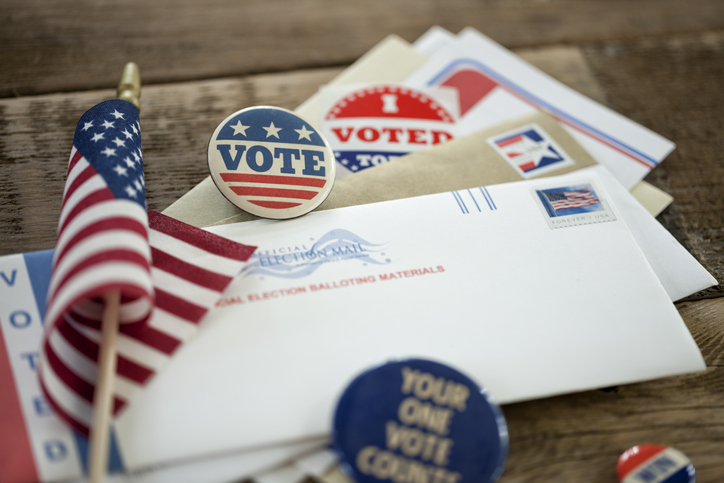
Mail-In Ballot Voter Fraud Is Extremely Rare
Mail-in ballot voter fraud is the biggest problem that doesn’t exist.
No one should have to choose between making their voice heard in a pivotal presidential election and risking their life by voting in person during a pandemic. That’s why states have taken measures in 2020 to make mail-in voting easier for and accessible to more voters. This fall, states like California are automatically sending ballots in the mail to all registered voters (rather than just those who explicitly request a ballot). Other states like New Mexico and Montana are passing laws to allow counties to make the decision to do the same.
With an estimated 83 percent of registered voters able to cast a mail ballot in 2020, some have responded with an air of suspicion about this method of voting. President Trump in particular has taken to Twitter to spread disinformation about the inevitability of widespread abuse and fraud that will follow unprecedented rates of voting by mail.

Myths are spreading like wildfire about the impact voting by mail will have on the integrity of American elections. But the numbers don’t lie—cases of mail-in ballot voter fraud are extremely rare in states where universal mail voting has been the norm for years.
Common Mail-In Ballot Voter Fraud Myths
If you’ve tuned into the news in any capacity in 2020, you’ve likely seen, read, or heard an argument against making it easier for Americans to vote by mail this fall. Most of these claims (largely made by power players on the Fox News circuit) boil down to:
• Fraud is rampant in states with universe mail voting. (FALSE)
• There is no secure way to administer ballots through the mail. (FALSE)
• Mail-in voting is a ploy by Democrats to manipulate the results of the 2020 election in their favor. (FALSE)
• Mail-in voting is totally new. Don’t you think there are good reasons why it hasn’t been done before? (FALSE)
• If we let people vote by mail, we’ll see prevalent abuse of the system, with people breaking the law to cast multiple votes, or even faking their identity to cast a ballot for a deceased individual. (FALSE)
What the Numbers Tell Us
Incidents of fraud connected with mail-in voting are largely anecdotal. In fact, a study conducted by the Washington Post in partnership with the nonprofit Electronic Registration Information Center (ERIC) identified only 372 potential instances of voter fraud out of 14.6 million votes cast by mail in Colorado, Oregon, and Washington in the 2016 and 2018 general elections—a staggeringly low 0.0025 percent of ballots cast in these elections.
States with universal mail-in ballot systems include Colorado, Washington, Oregon, Hawaii, and Utah. In these states, every registered voter automatically receives a ballot in the mail (without having to explicitly request one). In most cases, voters are then able to return their completed ballots either by sending them back in the mail or depositing them at designated drop boxes. After years of practice, election officials have strengthened layers of security in these systems to prevent fraud. Such measures include keeping voter rolls up to date, authenticating ballots by matching signatures, and analyzing voter history data to detect irregularities. Occasional instances of fraud or administrative errors are certainly in the realm of possibility when it comes to voting by mail, but it’s extremely rare.
One of the only high-profile cases of intentional ballot fraud in recent years didn’t involve an ordinary voter at all—instead, it revolved around a high-level Republican operative who was charged with tampering absentee ballots to influence the results of a North Carolina 2018 congressional race.
The numbers don’t lie. Making it easier for folks to vote by mail to avoid the spread of COVID-19 is unlikely lead to rampant fraud. As election official shared, “[S]he found it even more difficult to guarantee the integrity of the vote when she administered in-person contests.”
The White Whale of the Republican Party
In raising alarms about mail-in voter fraud, Republicans claim to be pursuing a problem that doesn’t even exist. What’s more, the message from the right on preventing fraud doesn’t match the Republican Party’s efforts to quietly encourage their own supporters to vote by mail as they rail against the method for everyone else. As President Trump continues to try to undermine state efforts to make mail-in voting easier, his son Don Jr. has been featured in robocalls deployed in 13 battleground states urging Trump supporters to vote by mail.
In the mail-in ballot voter fraud debate, the Trump Administration and the Republican Party are grasping for another way to suppress the vote in a decades-long journey to make it harder for those who don’t support them to make their voices heard. Jim Crow laws designed to disenfranchise Black Americans after the Civil War—from literacy tests to poll taxes to unpunished intimidation and violence—have been replaced by strict voter ID laws, racial gerrymandering, attempts to roll back the Voting Rights Act, and the latest attacks on the United States Postal Service. Mail-in ballot voter fraud isn’t the problem we should be tackling—attempts to disenfranchise Americans, particularly communities of color, should be our battle.
About two-thirds of Americans surveyed by Pew in June 2020 believe no-excuse mail-in voting should be available to any voter. In the midst of a pandemic, increasing access to safer methods of voting that don’t require standing in line in a crowd for hours (as happened on the day of the Wisconsin 2020 primary) will ensure anyone who wants to make their voice heard in a pivotal election can do so. By learning from states who have been administering universal mail voting for years without a hitch, we can so the same nationally—if we’re willing to try.